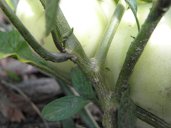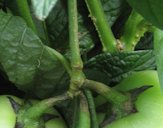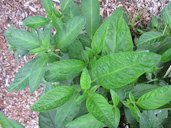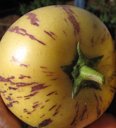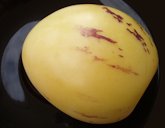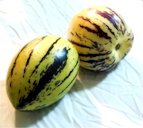| Pepino - Solanum muriticatum | |||||||||||||||||||
|---|---|---|---|---|---|---|---|---|---|---|---|---|---|---|---|---|---|---|---|
 Fig. 1  Pepino, Solanum muriticatum 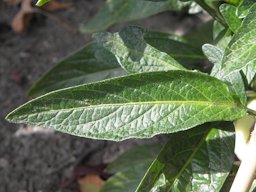 Fig. 2  S. muricatum, pepino melon 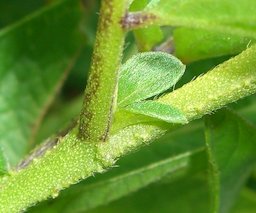 Fig. 3  Jardín Botánico José Celestino Mutis, Colombia 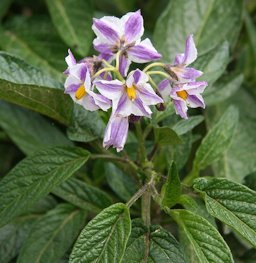 Fig. 7  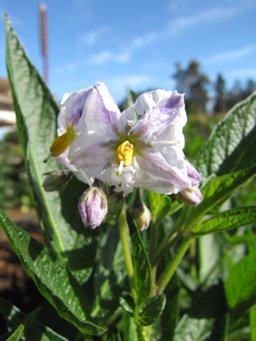 Fig. 8  Flower and flower buds Kula Experiment Station, Maui, Hawai'i 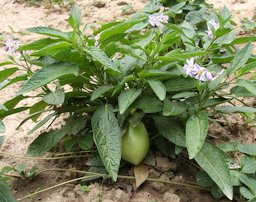 Fig. 9  S. muricatum flower and fruit 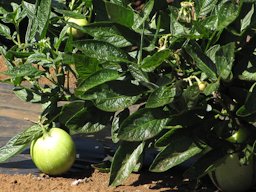 Fig. 10  Fruit and leaves, Kula Experiment Station, Maui, Hawai'i 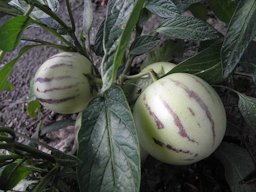 Fig. 11  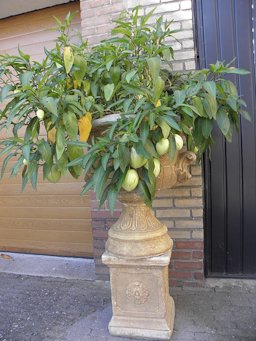 Fig. 18  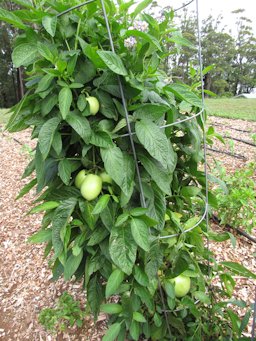 Fig. 19  Fruiting habit in vegetable garden, Olinda, Maui, Hawai'i.  Fig. 20  S. muricatum (Pepino dulce, melon pear), habit, Kula Experiment Station, Maui, Hawai'i 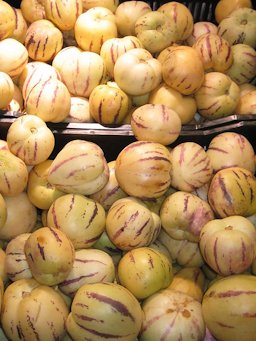 Fig. 21  Main commercial variety of S. muricatum seen at a supermarket in Lima, Peru 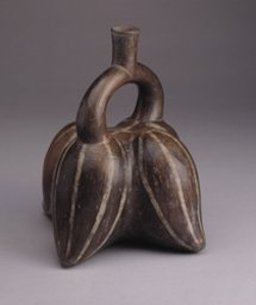 Fig. 22 Moche ceramic pepinos, Larco Museum Collection, Lima, Peru Fig. 23  Phytomorphic ceramics from pre-contact Peru representing the fruits of S. muricatum, Berlin-Dahlem, Ethnologisches Museum |
Scientific
name Solanum muriticatum Ait. Pronunciation so-LAN-num mur-ee-KAY-tum Common names English: pepino, sweet cucumber, pear melon, Peruvian pepino, melon pear, melon shrub, tree melon, sweet cucumber, mellowfruit; Quechua: cahum, xachum; Aymara: kachuma; Spanish: pepino, pepino dulce (Colombia, Ecuador,Peru, Bolivia), mataserrano (central and southern Peru), peramelon (Canaries) 2,4 Synonyms S. guatemalense Hort., S. hebephorum Dunal, S. longifolium Sessé & Moc., S. melaniferum Moric. ex Dunal, S. pedunculatum Roem. & Schult., S.saccianum Naudin, S. saccianum Carrière & André, S. scabrum Lam., S. variegatum Ruiz & Pav., S. wallisii Carrière, S. muricatum var. dissectum Dunal, S. muricatum f. glaberrimum Correll, S. muricatum var. papillosistylum Bitter, S. muricatum var. parvifolium Kunth, S. muricatum var. popayanum Bitter, S. muricatum var. praecedens Bitter, S. muricatum var. protogenum Bitter, S. muricatum var. teleutogenum Bitter 1 Relatives Wonderberry (Solanum X burbanikii), tzimbalo (S. caripense), lulita (S. pectinatum), lulo comun (S. pseudolulo), Naranjilla (S. quitoense), garden huckleberry (S. scabrum), cocona (S. sessiliflorum), tree tomato, tamarillo (S. betacea) 3 Distant Affinity Casana (Cyphomandra casana), tomato (Lycopersicon lycopsersicum), Mexican husk tomato, tomatillo (Physalis ixocarpa), Cape gooseberry, poha berry (Physalis peruviana) and others 3 Family Solanaceae (nightshade family) Origin Native to the temperate Andean regions of Colombia, Peru and Chile 3 USDA hardiness zones 8-11 9 Uses Food; gound cover Height 3.3 ft (1 m) 9 Spread Several feet across 3 Plant habit Herbaceous perennial; erect; low-lying; sprawling 2,3,9 Growth rate Fast Longevity Plant can continue to crop for two years 8 Trunk/bark/branches Multiple branching habit; woody base 2 Pruning requirement Prune as one would a tomato plant Leaves Highly variable shapes; usually simple but sometimes pinate; velvety 6 Flowers Perfect; five petals; blue below 68 °F (20 °C); white above 77 °F (25 °C) 6 Fruit Berry; globose to pointed oval; skin creamy to yellow orange; purple, green striping 5 Season Fruit matures 30 to 80 days after pollination 3 Light requirement Full sun to part shade Soil tolerances Thrives in moderately moist soils with good drainage pH preference 6.5-7.5 3 Drought tolerance Not tolerant Soil salt tolerance Not as tolerant of salinity as the tomato 3 Cold tolerance Survives 27-28 °F (-2.5 °C) for short periods Plant spacing 2-3 ft (0.6-0.9 m) between bushes 3 Roots Fibrous; spreading; shallow Invasive potential * None reported Pest resistance Afflicted by many of the same diseases/pests of other plants in the same genus Known hazard Although no specific mention of toxicity has been seen for this species, but it belongs to a genus where many have poisonous leaves and sometimes also the unripe fruits 9 Reading Material Pepino (Solanum muricatium), Neglected Crops Pepino Dulce, California Rare Fruit Growers Pepino, Lost Crops of the Incas "New" Solanums, Perspectives on New Crops and New Uses, Purdue University Origin The pepino Solanum muricatum, originates from the Andean region and has been domesticated since pre-Hispanic times. At present, it is known only as a cultivated species. Commercial crops produced with advanced technology are known in Chile, New Zealand and the United States (California) as a result of this fruit's acceptance on North American, European and Japanese markets. 2 The plant is not known in the wild, and the details of it origin are not known. The fruit is grown commercially in New Zealand, Chile and Western Australia. The pepino dulce was being grown in San Diego before 1889 and was listed by Francisco Franceschi of Santa Barbara in 1897. Improved cultivars were imported into California from New Zealand and elsewhere in more recent times. 3 Description The juicy and pleasantly aromatic fruit are extremely variable in shape and size, and some of them approach the cucumber in appearance, hence the name, pepino, Spanish for cucumber. Sometimes it is called pepino dulce ('sweet') or pepino de aqua ('of water') to distinguish it from the cucurbitaceous fruit. The preferred cultivars have fruit that are broadly ovate, yellow and purple stripes and 5-6 cm long. The better cultivars of the pepino set few or no seeds, hence propagation is vegetative. 7 The plant is small enough to be grown satisfactorily in a container (Fig. 18) 3 Descriptors for pepino (Solanum muricatum), Bioversity International pdf Leaves/Stems The bright green leaves are sparsely covered with very small hairs. In appearance the pepino dulce is much like a potato plant, but the leaves may take many forms–simple and entire, lobed, or divided into leaflets. 3
Flowers The small flowers are blue, violet-purple or white marked with purple, and are similar in form to unopened potato flowers. The plants will not set fruit until the night temperatures are above 65 °F (18.3 °C). 3 Temperatures, particularly above 86 °F (30 °C), at flowering time can cause the flowers to abort. 4 Pollination The plants are parthenocarpic, which means they need no pollination to set fruit. However, self-pollination or cross-pollination greatly encourages fruiting. 4 Fruit The fruit of cultivars grown in this country are usually round to egg-shaped, about 2 to 4 inches long, with some growing up to 6 inches. The skin is typically yellow or purplish green, often with numerous darker streaks or stripes. The flesh is greenish to white and yellowish-orange. Better quality fruit is moderately sweet, refreshing and juicy with a taste and aroma similar to a combination of cantaloupe and honeydew melon. In poor varieties there can be an unpleasant “soapy” aftertaste. 3
Fig. 12,13,14,15. Ripe pepino fruits Fig. 16. Green fruit, Olinda, Maui, Hawai'i Fig. 17. Unripe fruit, India Varieties Pepinos appear in markets throughout the Andes, but although there are many distinct strains, few have been stabilized into named cultivars. Chile has named varieties but no registered cultivars. In New Zealand, the most common cultivated varieties are El Camino and Suma. In California, New Yorker is the most widely grown cultivar. Since 1984, however, Miski Prolific has become equally popular. Pepinos grown with saline irrigation have become a premium export of Israel because of their tangy taste. 4 Solanum muricatum have been planted in southern Florida repeatedly, but have not performed well. Research is needed to develop cultivars adapted to Florida's specific climatic requirements. Harvesting Individual fruits should not be picked until they are completely mature to assure the highest flavor and sugar content. Different cultivars vary, but the ground color of many mature fruits is somewhat yellow to light orange. Ripe fruit also bruises easily and requires careful handling. Such fruit should store well for 3 to 4 weeks at around 38° F under relatively high humidity. 3 Since fruit mature sequentially, several harvests are necessary during the season. 5 Propagation Plants propagated vegetatively grow quickly and begin to flower in four or five months. Plants propagated by seed take longer to develop. In the laboratory, seedlings have been obtained even after 15 to 20 days of seed drying. 2 The pepino dulce is usually propagated vegetatively from cuttings. Three to five inch stem cuttings are taken leaving 4 or 5 leaves at the upper end. Treatment with rooting hormones will help increase uniformity in rooting and development of heavier root systems. The cuttings are then placed in a fast-draining medium and placed under mist or otherwise protected from excessive water loss. Bottom heat also is helpful. With the right conditions most of the cuttings quickly root and are ready for potting up in individual containers. Rooted cuttings set out after the danger of frost (February to April) should be large enough to start blooming shortly after planting. The fruit will then have time to grow and ripen during the warm summer months. 3 Planting The plant likes a sunny or semi-shaded, frost-free location, sheltered from strong winds. It does well planted next to a south-facing wall or in a patio. The pepino dulce does best in a fertile (but not too fertile), free draining, neutral soil. 3 A common practice in Peru is to mound the soil around the plants once the plants have atttained a certain size, to increase root formation and to get better anchored plants. 5 Pruning Pruning of the pepino dulce is not needed unless the plant is being trained to a trellis. In this case treat it as one would a tomato vine. Opening the fruits to light increases the purple striping and improves the general appearance. 3 Irrigation The pepino dulce is quite sensitive to moisture stress as their root systems spread out and are quite shallow. Irrigation techniques are thus crucial for the health of the plants as well as for pollination, fruit set and quality of the fruit crop. Some growers feel that overhead sprinkling may even favor increased pollination. Microjets appear to deliver moisture better than trickle irrigation. 3 Fertilizing The plants should be fertilized in a manner similar to a tomato plant, mixing in some well-rotted manure to the plant site several weeks in advance and supplementing with a 5-10-10 NPK granular fertilizer as needed. Soils that are too rich produce vigorous vegetative growth which can lead to reduced fruit set and quality, plus an increase in pest problems. 3 Pests/Diseases The plant is affected by many of the diseases and pests that afflict tomatoes and other solanaceous plants, including bacterial spot, anthracnose, and blights caused by Alternaria spp. and Phytophthora spp. 3 Food Uses Delicate and mild-flavored, pepinos are often eaten as a fresh snack fruit, though they combine very well with a number of other fruits as well. The pepino dulce is commonly chilled and eaten fresh much like a cantaloupe or other melons. 3 The pepino is so versatile that it can be a component of any part of a meal: refreshment, appetizer, entree, or dessert. South Americans and Japanese eat it almost exclusively as a fresh dessert. It is highly suited to culinary experimentation. For instance, New Zealanders have served it with soups, seafood, sauces, prosciutto, meats, fish, fruit salads, and desserts. The fruits can also be frozen, jellied, dried, canned, or bottled. 4 Pepinos are often peeled because the skin of some varieties has a disagreeable flavor. It pulls off easily, however. The number of seeds depends on the cultivar, but even when present, the seeds are soft, tiny, and edible, and because they occur in a cluster at the center of the fruit (Fig. 17) they are easily removed. 4 Nutritional Value As a source of vitamin C, the pepino is as good as many citrus fruits, containing about 35 mg per 100 g. It also supplies a fair amount of vitamin A. Otherwise, it is 92 percent water and only 7 percent carbohydrates. 4 Medicinal Properties ** Its nutritional value is low but it is recognized for its diuretic properties, probably because of its high water content (92 percent) and good iodine content, for which it is recommended for treating goitre. It also contains 29mg per 100 g of vitamin C. 2 General On the northern coast of Peru (in the Virti and Moche valleys), farmers believe that if pepinos are eaten after drinking liquor, death may result. Names and beliefs have contributed towards S. muricatum being grown in small areas and its introduction is still at the incipient stage. 2 In Japan, consumers have an insatiable appetite for pepinos, and in recent years they have bought them at prices among the highest paid for any fruit in the world. Pepinos are offered as desserts, as gifts, and as showpieces. Often they are individually wrapped, boxed, and tied with ribbons. Some trendy stores display pepinos whether they sell or not. 4 In Spanish, “pepino dulce” means “sweet cucumber.” Regrettably, the shortened name “pepino” is becoming the common name for this fruit in English, for in Spanish “pepino” refers only to the cucumber. This fruit, however, is botanically related to tomatoes and is nothing like a cucumber. 4 Other Edibles in the Solanum Genus: Cocona, S. sessiliflorum Naranjilla, S. quitoense Tamarillo, S. betaceum Further Reading Biodiversity of Food Species of the Solanaceae Family: A Preliminary Taxonomic Inventory of Subfamily Solanoideae, Resources pdf List of Growers and Vendors |
||||||||||||||||||
| Bibliography 1 "Solanum muriticatum Aiton synonyms." The Plant List (2013), Version 1.1, www.theplantlist.org/tpl1.1/record/tro-29601697. Accessed 26 Nov. 2020. 2 "Pepino (Solanum muricatium). Andean fruits." Neglected Crops 1492 from a Different Perspective, FAO Plant Production and Protection Series No. 26, pp. 181-185, Food And Agriculture Organization of the United Nations, Edited by J. E. Hernandez Bermejo and J. Leon, 1994, FAO, www.fao.org/docrep/018/t0646e/t0646e.pdf. Accessed 28 Nov. 2020. 3 "Pepino Dulce." California Rare Fruit Growers, crfg.org/wiki/fruit/pepino-dulce/. Accessed 28 Nov. 2020. 4 "Pepino." Lost Crops of the Incas: Little-Known Plants of the Andes with Promise for Worldwide Cultivation, National Research Council (U.S.), Advisory Committee on Technology Innovation, 1989, Internet Archive, Public Domain, archive.org. Accessed 29 Nov. 2020. 5 Duarte, Odilo and Robert E. Paull. Exotic Fruits and Nuts of the New World. Cambridge, CABI, 2015. 6 Blancke, Rolf. "Tropical Fruits and Other Edible Plants of the World: An Illustrated Guide." Zlibrary, 2016, b-ok.cc/book/3414166/f1bf9d?dsource=recommend. Accessed 30 Nov. 2020. 7 The Encyclopedia of Fruit & Nuts. Edited by Jules Janick and Robert E. Paull, Cambridge, CABI, 2008. 8 Tindall, H. D. "Vegetables in the Tropics." ZLibrary, 1983, b-ok.cc/book/2673274/1f1d65. Accessed 30 Nov. 2020. 9 "Solanum muricatum Aiton." Plants For A Future, (CC BY-NC-SA 4.0), pfaf.org/user/plant.aspx?latinname=Solanum+muricatum. Accessed 30 Nov. 2020. Photographs Fig. 1 Eglekuc. "Pepino cut in half." Wikipedia, 19 July 2008, (CC BY-SA 3.0), en.wikipedia.org/wiki/File:PepinoLT.jpg. Accessed 28 Nov. 2020. Fig. 2 Hille, Rob. "Solanum muricatum, pepino melon." Wikimedia Commons, 12 Sept. 2012, (CC BY-SA 3.0), commons.wikimedia.org/wiki/File:Solanum_muricatum_R.H._(3).jpg. Accessed 28 Nov. 2020. Fig. 3 Weigell, Philipp. "Jardín Botánico José Celestino Mutis, Colombia." Wikimedia Commons, 5 July 2008, (CC BY 3.0), commons.wikimedia.org/wiki/File:Solanum_muricatum_(4).jpg. Accessed 28 Nov. 2020. Fig. 4 Hille, Rob. "Solanum muricatum, pepino melon." Wikimedia Commons, 12 Sept. 2012, (CC BY-SA 3.0), commons.wikimedia.org/wiki/File:Solanum_muricatum_R.H._(6).jpg. Accessed 28 Nov. 2020. Fig. 5,16 Starr, Forest, and Kim. "Solanum muricatum (Pepino dulce, melon pear), green fruit, Olinda, Maui, Hawai'i." Starr Environmental, 8 May 2010, no. 100508-6092, (CC BY 4.0), www.starrenvironmental.com/images/image/?q=24742316330. Accessed 30 Nov. 2020. Fig. 6 Starr, Forest, and Kim. "Solanum muricatum (Pepino dulce, melon pear), leaves, Olinda, Maui, Hawai'i." Starr Environmental, 17 Feb. 2011, no. 110217-1521, (CC BY 4.0), www.starrenvironmental.com/images/image/?q=24449574573. Accessed 30 Nov. 2020. Fig. 7 I, Michael w. "Solanum muricatum Flower and Fruit." Wikimedia Commons, 28 July 2007, (CC BY 2.5), GFDL, commons.wikimedia.org/wiki/File:Solanum_muricatum_Flower2.jpg. Accessed 28 Nov. 2020. Fig. 8 Starr, Forest, and Kim. "Solanum muricatum (Pepino dulce, melon pear), flower, Kula Experiment Station, Maui, Hawai'i." Starr Environmental, 20 Oct. 2009, no. 091023-8519, (CC BY 4.0), www.starrenvironmental.com/images/image/?q=24691276900. Accessed 30 Nov. 2020. Fig. 9 I, Michael w. "Solanum muricatum Flower." Wikimedia Commons, 28 July 2007, (CC BY 2.5), GFDL, commons.wikimedia.org/wiki/File:Solanum_muricatum_Flower_and_Fruit.jpg. Accessed 28 Nov. 2020. Fig. 10 Starr, Forest, and Kim. "Solanum muricatum (Pepino dulce, melon pear), fruit and leaves, Kula Experiment Station, Maui, Hawai'i." Starr Environmental, 20 Oct. 2009, no. 091020-8387, (CC BY 4.0), www.starrenvironmental.com/images/image/?q=24355888854. Accessed 30 Nov. 2020. Fig. 11 Hille, Rob. "Solanum muricatum, pepino melon." Wikimedia Commons, 12 Sept. 2012, (CC BY-SA 3.0), commons.wikimedia.org/wiki/File:Solanum_muricatum_R.H._(5).jpg. Accessed 28 Nov. 2020. Fig. 12 Starr, Forest, and Kim. "Solanum muricatum (Pepino dulce, melon pear), fruit in hand, Kula Experiment Station, Maui, Hawai'i." Starr Environmental, 23 Oct. 2009, no. 091023-8515, (CC BY 4.0), Image Cropped, www.starrenvironmental.com/images/image/?q=24356173454. Accessed 30 Nov. 2020. Fig. 13 NobbiP. "Solanum muricatum, Pepino." Wikimedia Commons, 29 Apr. 2012, (CC BY-SA 3.0), GFDL, commons.wikimedia.org/wiki/File:Solanum_muricatum,_Pepino_24.jpg. Accessed 28 Nov. 2020. Fig. 14 NobbiP. "Solanum muricatum, Pepino." Wikimedia Commons, 29 Apr. 2012, (CC BY-SA 3.0), GFDL, commons.wikimedia.org/wiki/File:Solanum_muricatum,_Pepino_28.jpg. Accessed 28 Nov. 2020. Fig. 15 Davidals. "Ripe pepino fruits." Wikimedia Commons, 10 Feb. 2011, (CC BY-SA 3.0), commons.wikimedia.org/wiki/File:Ripe_pepinos.jpg. Accessed 28 Nov. 2020. Fig. 17 "Solanum muricatum, farm in Kanthaloor, Idukki district, Kerala." efloraofindia, Database of Plants of Indian Subcontinent, 6 June 2014, sites.google.com/site/efloraofindia/species/m---z/s/solanaceae/solanum/solanum-muricatum. Accessed 1 Dec. 2020. Fig. 18 Hille, Rob. "Solanum muricatum, pepino melon." Wikimedia Commons, 12 Sept. 2012, (CC BY-SA 3.0), commons.wikimedia.org/wiki/File:Solanum_muricatum_R.H._(7).jpg. Accessed 28 Nov. 2020. Fig. 19 Starr, Forest, and Kim. "Solanum muricatum (Pepino dulce, melon pear), fruiting habit in vegetable garden, Olinda,, Maui, Hawai'i." Starr Environmental, 8 May 2010, no. 100508-6091, (CC BY 4.0), www.starrenvironmental.com/images/image/?q=24670235649. Accessed 30 Nov. 2020. Fig. 20 Starr, Forest, and Kim. "Solanum muricatum (Pepino dulce, melon pear), habit, Kula Experiment Station, Maui, Hawai'i." Starr Environmental, 20 Oct. 2009, no. 091020-8374, (CC BY 4.0), www.starrenvironmental.com/images/image/?q=24868468492. Accessed 30 Nov. 2020. Fig. 21 Hermann, Michael. "Main commercial variety of Solanum muricatum seen at a supermarket in Lima, Peru." Wikimedia Commons, 25 Nov. 2003, (CC BY-SA 3.0), commons.wikimedia.org/wiki/File:Solanum_muricatum_Lima_Santa_Isabel.jpg. Accessed 28 Nov. 2020. Fig. 22 User MGA73bot2. "Moche ceramic pepinos. Larco Museum Collection, Lima, Peru." Wikimedia Commons, 8 Aug. 2007, (CC BY-SA 3.0), GFDL, commons.wikimedia.org/wiki/File:Moche_Pepinos.jpg. Accessed 28 Nov. 2020. Fig. 23 Hermann, Michael. "Phytomorphic ceramics from pre-contact Peru representing the fruits of Solanum muricatum. Berlin-Dahlem, Ethnologisches Museum." Wikimedia Commons, 20 July 2011, (CC BY-SA 3.0), Image Cropped, commons.wikimedia.org/wiki/File:Dahlem_Ethnologisches_Museum_Amerika_Solanum_muricatum.JPG. Accessed 28 Nov. 2020. * UF/IFAS Assessment of Non-native Plants in Florida's Natural Areas ** Information provided is not intended to be used as a guide for treatment of medical conditions. Published 1 Dec. 2020 LR. Last update 10 Apr. 2023 LR |
|||||||||||||||||||
